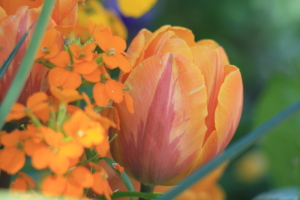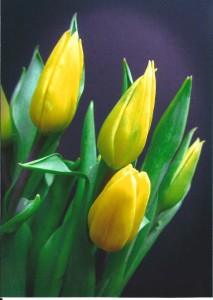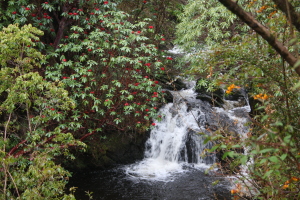Tillsonburg Horticultural Society takes in Buffalo Garden Festival
It’s Still Just Dirt – August 2014, The Tillsonburg News
by Penny Esseltine
At the end of July, Tillsonburg Horticultural Society members crossed the Canada/U.S. border for an international bus tour taking in the Buffalo National Garden Festival (throughout the area) and Garden Walk Buffalo (370 gardens located in clusters within a three mile radius in the city). Our guide Sally Cunningham says, “We are real proud of what’s happened in this region. Twenty years ago 16 neighbours said let’s do a garden tour and now there are 370 gardens in Buffalo that are now seen by as many as 55,000 people in just one weekend of Garden Walk Buffalo.”
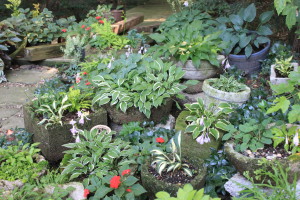 Our first Festival stop is Marcia Sully’s Hidden Gardens of Eden, in Eden, New York. Sally says this is one of the most respected gardens in the region. Marcia likes to under grow plants under plants, and many, many pots. Marcia says it takes her three hours each day just to water the pots. She has hypertufa (hand-made) pots as well as old fashioned tin washtubs, filled with hosta pots, and even birdbaths pot filled with as many as 12 different kinds of succulents.
Our first Festival stop is Marcia Sully’s Hidden Gardens of Eden, in Eden, New York. Sally says this is one of the most respected gardens in the region. Marcia likes to under grow plants under plants, and many, many pots. Marcia says it takes her three hours each day just to water the pots. She has hypertufa (hand-made) pots as well as old fashioned tin washtubs, filled with hosta pots, and even birdbaths pot filled with as many as 12 different kinds of succulents.
For the hardier plants Marcia pulls pots in close to the house in the fall and tips them on their side so that water won’t accumulate too much. For the more tender plants in her garden she digs them up and takes them, bare-rooted in pans, all the way to her Florida winter home where she plants them in the garden there.
Tillsonburg Horticultural Society tour organizer Christine Nagy says that in the 15 years she’s been touring gardens this is the best she has seen. “The imagination and creativity is amazing.”
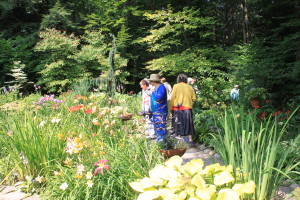 Smug Creek Gardens in Hamburg, New York is next. It’s home to King of the Hosta World Mike and Day Lily Queen Kathy. Mike tells us they have four gardens, all in virgin woodland, including four terraces up the hill with plants like day lilies, hydrangea and rudbeckia, a garden of small hostas (up to 12 inches tall) in rockery in the shade, a garden in a bog with raised beds to keep the roots out of the water, and a hosta glen. The deck too is a garden with more than 100 plants in pots. Thirteen acres in total and everything is labelled.
Smug Creek Gardens in Hamburg, New York is next. It’s home to King of the Hosta World Mike and Day Lily Queen Kathy. Mike tells us they have four gardens, all in virgin woodland, including four terraces up the hill with plants like day lilies, hydrangea and rudbeckia, a garden of small hostas (up to 12 inches tall) in rockery in the shade, a garden in a bog with raised beds to keep the roots out of the water, and a hosta glen. The deck too is a garden with more than 100 plants in pots. Thirteen acres in total and everything is labelled.
Thursday morning starts in a modest income area of central Buffalo where Garden Walk Buffalo began. On 16th Street Joe and Scott’s amazing place has every kind of coleus known to man. One hundred and fifty pots planted with annuals each year. Joe says, “It’s always evolving, something different every year, mostly coleus. I sprinkle Miracle Grow in the hole before I plant.”
Dom and Arlan’s home on Norwood Ave was built in 1890. For 25 years now they have been focussing on the gardens, doing it themselves. Don says it’s important to remember that, “If you don’t know what you are doing at least be neat.” There are two silver maples the same age as the house, statuary, potting benches, a fountain and strawberry plants between the steps to the enclosed patio. Lastly there’s a miniature Alpine garden with moving train and a running water wheel on the way out.
On Summer Street in the cottage district (small homes built in the 1800s) we see the space between the houses and the sidewalk and the sidewalk and the street filled with 6 foot high gardens with shrubs and perennials like menarda, cone flowers, flocks, and hollyhocks. Wood houses are painted yellow, orange, blue, and shades of green with pretty fences, lane ways and walkways through to backyards. There are trumpet vines laden with orange flowers and glorious hanging baskets.
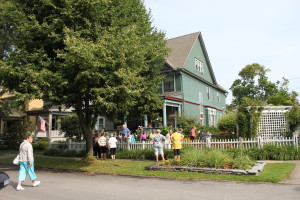 Later we move to Lancaster Avenue with its Queen Anne, Italianate, and Victorian style homes. There are large relaxing, plant-filled front verandahs everywhere.
Later we move to Lancaster Avenue with its Queen Anne, Italianate, and Victorian style homes. There are large relaxing, plant-filled front verandahs everywhere.
Picture day lilies filling the space between white picket fences and the sidewalk, huge angel wing begonias beside pathways and 12 foot tall dahlias in colours ranging from magenta, to orange, to maroon with white centres, and yellow with pink centres.
There are large potted coleus on three tiers of an elegant metal shelf, passion flowers blooming on garage walls and salmon coloured canna lilies hiding a backyard porch. We wonder, are the gardens on steroids? Sally says the gardens have never looked better. “Probably due to the ample rain and coolish weather.”
Further along sunflowers fill the space between the sidewalk and curb, black wooden window boxes hang from second storey windows with lush red begonias and beautiful trailing vines. At least eight different wind chimes sway in a mature maple tree, and 36 original birdhouses hang on a neighbour’s garage wall at the back of a garden.
Finally, in the side yard of an 1897 Dutch colonial revival home there’s a Harry Potter garden with children’s climbing apparatus and gardens filled with plants called mimbulus mibletonia, flaxseed, scurvy grass, wolfsbane, dittany and gillyweed.
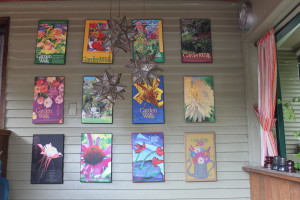 Andrew Sprung writing in TheAtlantic.com says, “A Buffalo-style garden will have the patina of a well-used, customized space, often with complete disregard for garden design conventions. Buffalo gardeners take advantage of the sides of houses and fences by hanging artwork, sculptures, grates, mirrors, plants and more. In Buffalo, you’ll find small urban gardens that pack a big punch including cheerfully brash juxtapositions of colourful perennials and unique annuals, minimal or no lawns, and creative uses of found objects and architectural artifacts as sculpture.”
Andrew Sprung writing in TheAtlantic.com says, “A Buffalo-style garden will have the patina of a well-used, customized space, often with complete disregard for garden design conventions. Buffalo gardeners take advantage of the sides of houses and fences by hanging artwork, sculptures, grates, mirrors, plants and more. In Buffalo, you’ll find small urban gardens that pack a big punch including cheerfully brash juxtapositions of colourful perennials and unique annuals, minimal or no lawns, and creative uses of found objects and architectural artifacts as sculpture.”
For information about Garden Walk Buffalo visit gardenwalkbuffalo.com. National Garden Festival information is available at nationalgardenfestival.com and for information about the Tillsonburg Horticultural Society visit tillsonburghorticultural.ca.
